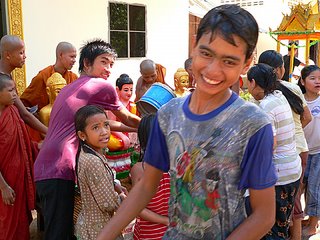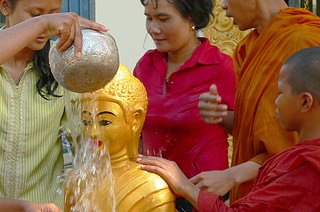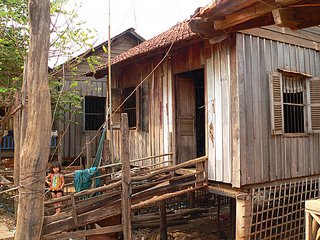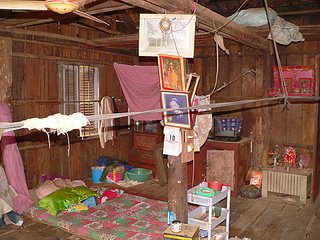Saturday, April 22, 2006
Getting enough water?
La has been doing classes in computing as part of his studies. He has been learning about the internet and using programs such as Internet Explorer and Outlook Express. However, his studies are done in Kompong Chhnang where internet connection can only be done by long-distance telephone and the cost is prohibitive except for emergencies. When La uses these programs, he uses them on a local area network.
I wanted him to have some experience of what the internet has to offer so a few weeks ago I shouted him a day with me in Phnom Penh. He had three hours of surfing.
When he arrived at my room in the morning, I was pouring some water into the bottle I use on a daily basis. It occurred to me that I never see him drink water when he is away from home. For that matter, I don't see many of my Khmer friends drink water. I said to him, 'Do you want a bottle of water to take with you?' He did. It then occurred to me that the reason I don't see them drinking water is the cost.
Most homes have a pump to bring water up from under the ground. A few have a filter to make that water drinkable. Some just boil it. It probably wouldn't pass as drinkable water in a Western country but that is what most seem to have. And when they are away from home they go without. Perhaps they have learned to do so out of necessity. The cost of bottled water seems low enough to me but with their limited income it is a luxury.
As we left my room, there was Lee in the room opposite, sitting with a drip in his arm. 'Are you OK?' I asked.
'No,' he answered. 'I don't drink enough water.'
*****
If you read my blog often, you might remember that I mentioned a book I was reading at my son, David's house before I left Australia in February. The book is 'Becoming your own therapist' by Lama Yeshe. The book, in my opinion, gives the essence of what the Buddha taught and how it relates to our daily lives. I highly recommend it and have recently discovered that you can download it (and a lot of other good stuff) for free from here: http://www.buddhanet.net/ebooks_ms.
I wanted him to have some experience of what the internet has to offer so a few weeks ago I shouted him a day with me in Phnom Penh. He had three hours of surfing.
When he arrived at my room in the morning, I was pouring some water into the bottle I use on a daily basis. It occurred to me that I never see him drink water when he is away from home. For that matter, I don't see many of my Khmer friends drink water. I said to him, 'Do you want a bottle of water to take with you?' He did. It then occurred to me that the reason I don't see them drinking water is the cost.
Most homes have a pump to bring water up from under the ground. A few have a filter to make that water drinkable. Some just boil it. It probably wouldn't pass as drinkable water in a Western country but that is what most seem to have. And when they are away from home they go without. Perhaps they have learned to do so out of necessity. The cost of bottled water seems low enough to me but with their limited income it is a luxury.
As we left my room, there was Lee in the room opposite, sitting with a drip in his arm. 'Are you OK?' I asked.
'No,' he answered. 'I don't drink enough water.'
*****
If you read my blog often, you might remember that I mentioned a book I was reading at my son, David's house before I left Australia in February. The book is 'Becoming your own therapist' by Lama Yeshe. The book, in my opinion, gives the essence of what the Buddha taught and how it relates to our daily lives. I highly recommend it and have recently discovered that you can download it (and a lot of other good stuff) for free from here: http://www.buddhanet.net/ebooks_ms.
Tuesday, April 18, 2006
Happy new year


 A few years back I was in Bangkok at the time of Songkran, the Thai new year festival. For days before and after the actual date of the new year there was water flying everywhere. On the actual new year night my friends took me into Khao San Road where there were huge crowds painting each others faces with 'powder' (which I think was actually white clay).
A few years back I was in Bangkok at the time of Songkran, the Thai new year festival. For days before and after the actual date of the new year there was water flying everywhere. On the actual new year night my friends took me into Khao San Road where there were huge crowds painting each others faces with 'powder' (which I think was actually white clay).The Cambodian people celebrate Khmer new year at the same time as the Thais celebrate theirs. So here I am in Kompong Chhnang enjoying the celebration. In fact, if anyone happens to be wondering why my weekly blog did not appear on Saturday as usual, it is because I decided against taking my computer to Phnom Penh the first day after the new year. I didn't know how enthusiastic the Cambodians would be about drenching strangers and their belongings. So this blog is being posted on Tuesday instead. I have no classes until later in the week, so my plan is to stay in PP overnight and catch up on a few things.
On Wednesday La dropped in and invited me to come to Wat Xam for the washing of the Buddha. I had never been inside the actual Wat, so this was an opportunity to take a look at it from the inside. I was a little concerned about getting my camera wet but La convinced me that people would allow me to stay dry.
At the wat there was a crowd gathered around the well drawing water and carrying it into the temple. I took a few photos but kept my distance. La went over to the well and came back drenched. By this time the crowd had dispersed from the temple so I went inside and took a few photos. The floor inside was wet and care was needed when walking. Outside people were washing some of the stupas.
We walked around the grounds and found there were a few Buddha images set up for those who still had enthusiasm to wash them. But of course with all that water it was perhaps difficult to put it only on the Buddha images. Sometimes a little went over your friend—and somtimes a lot—and sometimes it also went over the monks in attendance. And of course if your friend spilt water on you it was necessary to retaliate. While this was fairly low key compared to what I have seen in Bangkok I could see how the tradition grew into what it is in Thailand today.
I asked La if there was any symbolism in the washing of the Buddha images. He said no but after a year it was time to clean all the dirt and dust off them. Obviously everyone wants to get into the act and considering the temperature is in the high thirties who cares if you get a little wet in the process.
A few bucket carrier's eyes lit up when they saw me and from time to time I was concerned for my camera but once they saw what I was carrying I was left alone. I got to take many photos and managed to stay dry as well.
There has been much partying since. Parties sometimes include 'traditional Khmer games'. Anyone reading this who has attended Games for the Fun of It at the Relaxation Centre in Brisbane would recognise some similarities. While the Khmer games may have less emphasis on noncompetitiveness, all were played in a noncompetitive spirit. I know it was sometimes difficult to get Australians to drop their competitiveness when playing. In any case, it seems to me that traditional games like traditional stories travel across borders.
At none of the parties was drenching with water practised and I have seen no more drenching since the first day at the wat. The powder tradition was popular at one or two public gatherings. The powder used here is talcum powder and it was used without water. It seems that like Australia people here behave in different ways. When applying powder some act bravely and some cowardly. In Khmer society touch between the sexes in public is usually considered unacceptable. This is one time when the barriers break down and young men and women are free to touch each other's faces. Some handle it well, they approach a target with a handful of powder and let it be known that they would like to spread some powder on that person's face. The recipient then has the opportunity to accept or say 'no'. Perhaps fear of rejection is too much for some (usually young males) to handle so they cope with the situation by coming up behind an unsuspecting target with the handful of powder. You might be dancing and suddenly you are assaulted by someone's hand rubbing powder into your facial orifices. By time you turn around and perhaps remove the powder from you eyes the gutless attacker has disappeared into the crowd. Some of the young women react very quickly and swing a few blows but most remain amazingly under control. I have to admire their ability to accept this gross assault on their person. I found retaining similar control quite challenging.
A monk remarked to me that powder was not part of the Khmer tradition. I asked where it came from. He said 'Thailand'. I pointed out to him that my experience during several hours in Khao San Road was that 'powder' was put on my face thousands of times and done gently by 99.9% of those participating. And that unfortunately my experience here in Kompong Chhnang was not so pleasant.
The other aspect of many new-year parties here in Kompong Chhnang is what I would call an excessive volume from huge speakers. At all hours of the day and night over the past week and a half my ears have been assaulted. I attended one party where a bank of speakers about three metres high was set up in an otherwise-empty rice field. I guess it had to be loud to drown the noise of the generator that was powering it. Last night I was invited to visit a rural village for their party. It was a bad decision. I had no way of leaving. When I was ready to sleep I was given a sleeping mat under a mosquito net in a house with no internal walls. It probably acted as an amplifier for the speaker below. This was one of the palm-leaf homes with gaping floorboards. Fumes from the diesel generator drifted in along with the noise. I guess the dancers gave up at about two am and then the karaoke stars took over. At four am I went and found a log to sit on in a rice field. Someone rigged up a hammock for me and I did get a little sleep before we returned at daybreak. Last Sunday morning I decided to abandon my room because of speeches being broadcast from a house two doors away. They started at 5.30 am. I estimate that I rode my bicycle about two kilometres before I was out of range of the broadcast.
To me, such volumes are excessive. Even if the choice of music was my own, rather than that which I am learning quickly to dislike, I believe that at 50% of the volume it would still be too loud.
I trust you have a quiet and peaceful new year.
Additional new year photos will be posted in due course: http://www.flickr.com/photos/johnstory/
Saturday, April 08, 2006
Sokun's home


 Once a week I go to the temple in Kompong Osleah and teach English to the monks. Sokun teaches this class on a daily basis. After a recent visit he invited me to see his home. I thought you, my readers, friends and relatives might like to see how he lives so I asked if I could return a few days later with my camera.
Once a week I go to the temple in Kompong Osleah and teach English to the monks. Sokun teaches this class on a daily basis. After a recent visit he invited me to see his home. I thought you, my readers, friends and relatives might like to see how he lives so I asked if I could return a few days later with my camera.The house does not actually belong to Sokun. It belongs to a family that adopted him when he was a child. I don't fully understand this process. He says that he was sick and his family 'sold' him to another family in the belief that he would be cured by living with this new family. He did get better so I guess they feel that justified the process. His adopted parents now live in a village about 8 km out of town. Sokun's house is for sale but there are no takers. Until it is sold, Sokun is able to stay there.
As you can see the house is raised from the ground by stilts. The street level is less than a metre below the house. The natural ground level is several metres below this. In the rainy season the area under the house will be flooded. I'm not sure how high the water rises. Perhaps I'll have photos to show in a few months time.
As I walked up the ramp I found it to be a little unstable and I walked carefully in case it gave way. When I entered, Sokun opened the window shutters to let some light in. There is no glass in the windows. The neighbour's house is much the same and they were playing music. You can see from the photo how close the houses are together. I trust Sokun's taste in music and his sleeping habits are compatible with theirs.
There are two rooms in the house. Well, two rooms plus something the size of a cupboard in a back corner which contains the toilet. The front room is the living room and bedroom all in one. That's it in the second photograph. Sokun is fortunate to have the luxury of a fan to keep him cool when temperatures rise to the high thirties and occasionally low forties. (We've been getting 37 quite regularly of late.) There are gaps in the floorboards through which he can watch the waters rise in the rainy season. The gaps and the open windows off course let the mosquitos in so he is fortunate to have a mosquito net. The black and white photograph on the pillar in the middle is Sokun's father (not sure which one). The photo above that shows Sokun and his brother as monks.
The back room contains the cooking area, and the bathroom. Yes, he has running water but he has to pump it from under the ground and he tells me it often comes out a little red. The cooking area is shown in the third photo. Cooking is done over a charcoal fire and yes, he uses this regularly. Risk of fire, which would spread quickly, is high in villages like this.
There is a laneway alongside the house. I thought it might be for people going to the houses behind. The house immediately behind is less than a metre from the back of Sokun's house. The laneway in fact leads to the back of Psar Leuh, the upper market, so it is quite busy. In the rainy season this lane is under water and apparently people go a different way.
As this page is for text rather than pictures, may I direct you to 'my latest photos' page where you will find a few more photos of Sokun's home. If you are reading this within a week of the date I post it, they should be at the top of the page. As time goes by you will have to scroll down, perhaps through several pages, to find them.
Sokun's transport is the same as mine, a bicycle. Perhaps the more wealthy in this village own a motorcycle but a car would not be practical. The road outside is no wider perhaps than your driveway. In fact, the whole of Sokun's house may be smaller than your garage.
Sokun is 24 years old. He is quite intelligent but is still studying high school and has just completed grade ten owing to having missed many classes as a child. He also teaches several English classes each day. For this he is given an allowance from the monastery. It comes to 80,000 reil per month. Sounds a lot but in fact it is less than $A30. Half of that would eat up the electricity bill for my room. I'm not sure how well he eats on this amount.
When Sokun completes his studies he hopes to become a migratory worker in Korea for about three years. He believes this will allow him to save enough money to buy a house such as this one and then he will feel he will be able to marry and raise a family. Until then the girls in town can be no more than friends.
I am attempting to show here a little of the lifestyle of some of the people in Kompong Chhnang, Cambodia. Yes, there are many who live a much better lifestyle than Sokun. However, I can assure you there are many who are far worse off than he is.
Saturday, April 01, 2006
Meet my class
 I would like to tell you a little about the students in my mixed class. I can do this because we have been working on a 'getting to know you' unit. As a way of using the language involved in this unit I conducted a survey of class members.
I would like to tell you a little about the students in my mixed class. I can do this because we have been working on a 'getting to know you' unit. As a way of using the language involved in this unit I conducted a survey of class members. This was done over a few lessons and numbers varied from day to day between 26 and 32. Our data collection methods may not be scientific but that wasn't the purpose of the exercise. I think this still gives a broad overall picture of my students.
Ages in my class range from 12 to 28 with the average age being 17.6 years.
The three shortest class members are each 130 cm tall. The greatest number of girls/women is in the 156—160 cm range. The greatest number of boys/men is in the 161—165 cm range.
Weights range from 27 kg to 63 kg. The average weight is around, or perhaps just under, 44 kg. Compare this with Australians in the same age bracket and I think you'll agree that none of my class is overweight. In fact, only two class members are heavier than me.
Most of my students still study in regular day school as well as attending English classes at night. Grades range from six to 11. Often students are in a much lower grade than might be indicated by their age owing to missing school because of an inability to pay daily fees. Universal free education still does not exist in Cambodia.
The most popular school subject is English (just as well), followed by Khmer and biology. Eight students have been studying English for four years, the rest for less than that.
None of my students is married.
I suspect my students are not exposed to as wide a range of music as we in the West. 63% stated that their favourite music was 'pop' while 37% preferred Khmer traditional music.
I explained to them that a hobby was something that you did in your free time. When I asked for their favourite hobby, the greatest number said that it was studying. I guess one can study in free time so I accepted this. My assumption is that this reflects their commitment to getting out of poverty. The next most popular hobbies were listening to music and reading. When I asked this question of my students in Thailand, watching TV rated quite highly. Only two of my Cambodian students gave watching TV as their first choice. This may have something to do with a low incidence of TV ownership.
Most students were born in Kompong Chhnang province.
My students call me 'cher' which is their abbreviation of 'teacher'. In Khmer language the stress is usually on the last syllable and Cambodians often do the same in English, in this case to the extent of dropping the first syllable altogether.
My students are generally quite shy, polite and pleasant to teach. We have had a lot of fun getting to know each other.